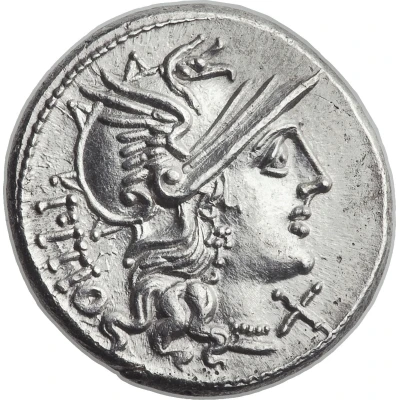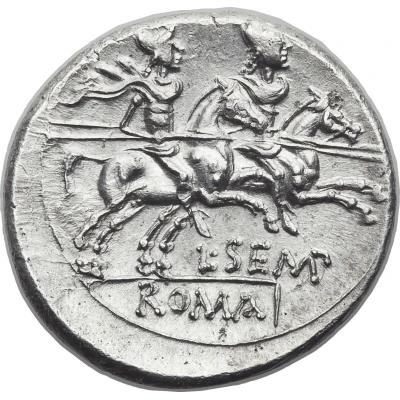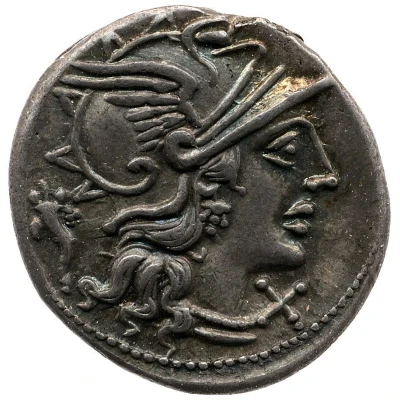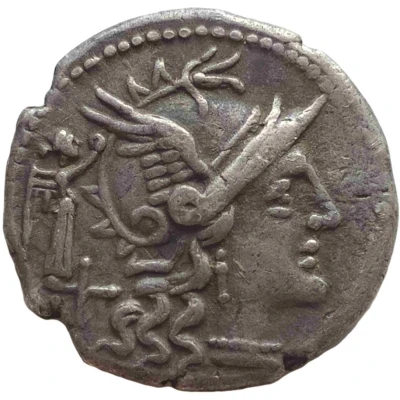
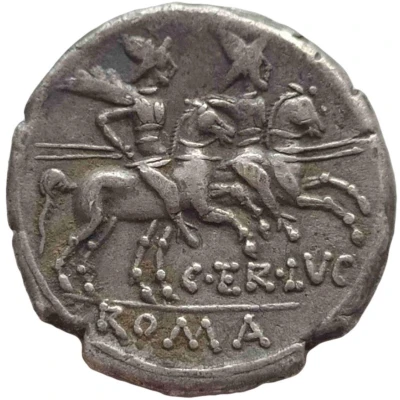

© mage
Denarius Terentia: Caius Terentius Lucanus; C TER LVC ROMA 147 BC
147 BC year| Silver | 3.92 g | 19 mm |
| Issuer | Rome › Roman Republic (509 BC - 27 BC) |
|---|---|
| Period | Republic (509 BC - 27 BC) |
| Type | Standard circulation coin |
| Year | 147 BC |
| Value | Denarius (1) |
| Currency | Denarius of 10 Asses (221 – 141 BC) |
| Composition | Silver |
| Weight | 3.92 g |
| Diameter | 19 mm |
| Shape | Round (irregular) |
| Technique | Hammered |
| Orientation | Variable alignment ↺ |
| Demonetized | Yes |
| Updated | 2024-10-06 |
| Numista | N#245500 |
|---|---|
| Rarity index | 92% |
Reverse
Dioscuri on horseback galloping right, cloak floating behind, each holding an horizontal spear; below, moneyer mark; inscription in exergue.
Script: Latin
Lettering:
C·(TE)R·LVC
ROMA
Unabridged legend: Caius Terentius Lucanus
Translation: Caius Terentius Lvcanus
Comment
The gens Terentia was a plebeian family in ancient Rome. Dionysius mentions a Gaius Terentilius Arsa, tribune of the plebs in 462 BC, but Livy calls him Terentilius, and from inscriptions this would seem to be a separate gens. No other Terentii appear in history until the time of the Second Punic War. Gaius Terentius Varro, one of the Roman commanders at the Battle of Cannae in 216 BC, was the first from this gens to hold the consulship. Members of this family are found as late as the third century AD.The antiquarian Varro derived the nomen Terentius from a Sabine word, terenus, meaning "soft". However, Chase suggests a Latin origin, from terens, one who grinds or threshes, and classifies the name among those gentilicia which either originated in Rome, or cannot be shown to have come from anywhere else.
The chief praenomina of the Terentii were Marcus, Gaius, Aulus, and Publius, all of which were very common throughout Roman history. The main families of the Terentii used the cognomina Culleo, Lucanus, and Varro. Of these, Varro seems to be derived from the same root as the Latin baro, a fool; Culleo refers to a leather sack or pouch, and may have referred to a leatherworker; while Lucanus signified an inhabitant of Lucania, and must have been given to one of the Terentii who either came from or perhaps had some connection with that region, or its people.
Interesting fact
The Denarius coin was minted during the Roman Republic, a time when Rome was still a republic and not yet an empire. The coin features an image of the Roman goddess Roma on one side and the letters "C TER LVC ROMA" on the other, which stand for "Caius Terentius Lucanus, Roman Consul." This coin was used as a standard form of currency throughout the Roman Republic and was valued at 1/100th of a Roman pound. I hope you find this information helpful and interesting!
Price
| Date | Mintage | VG | F | VF | XF | AU | UNC |
|---|---|---|---|---|---|---|---|
| ND (-147) | - | - | - | - | - | - |
Values in the table are based on evaluations by sales realized on Internet platforms. They serve as an indication only for Denarius (Terentia: Caius Terentius Lucanus; C TER LVC ROMA) (147 BC) coin.
